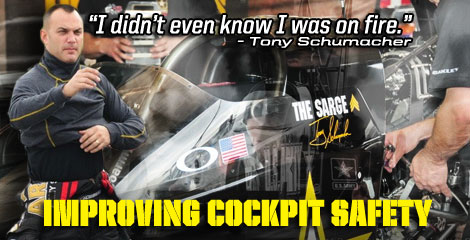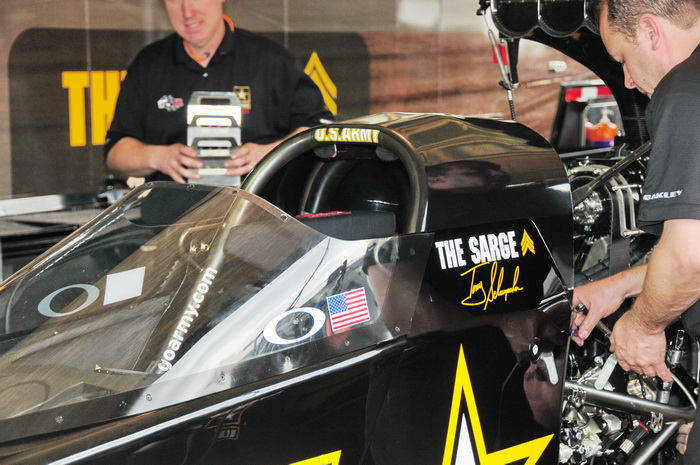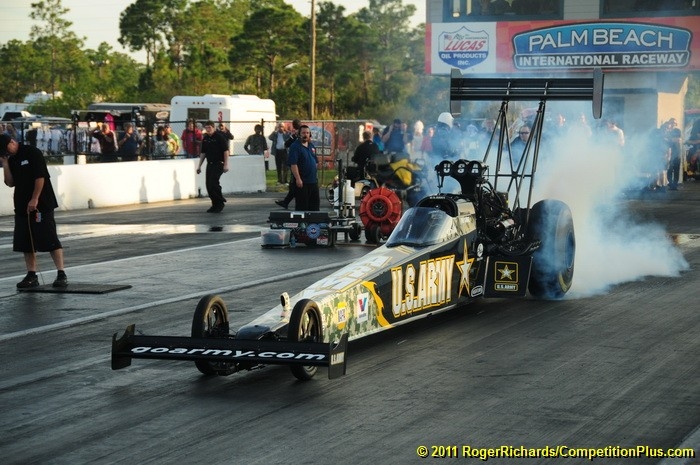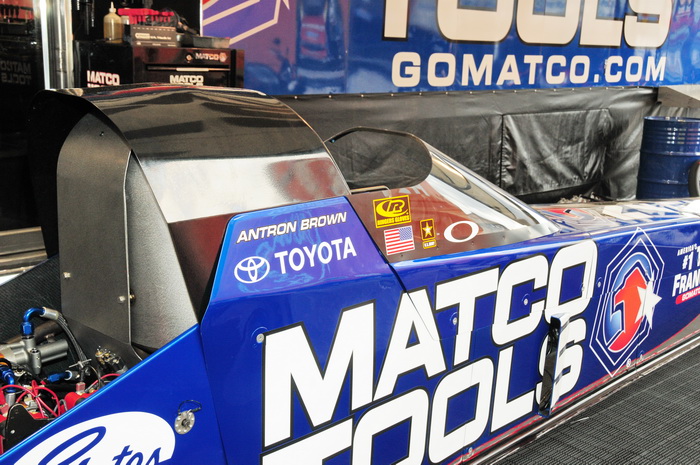DSR'S PURSUIT OF A SAFER COCKPIT
 Somewhere deep in the bowels of an 8000 horsepower beast a part fails and within milliseconds, shards of hot metal, parts, hot oil and fire are expanding outward in all different directions.
Somewhere deep in the bowels of an 8000 horsepower beast a part fails and within milliseconds, shards of hot metal, parts, hot oil and fire are expanding outward in all different directions.
With most motors detonating deep into the run of a Top Fuel dragster, the fans in the stands are relatively safe from the flying debris and spreading flames. Sitting in the cockpit, inches ahead of the motor, the driver is in definite peril. Amazingly, those parts and pieces, along with the fireball, expand far enough forward, despite the 200 – 300 mile per hour speed, to put the driver in real danger of being hurt.
Seven-time NHRA Top Fuel Champion Tony Schumacher experienced such an explosion on the first day of testing at Palm Beach International while preparing for the 2011 NHRA Full Throttle season.
“I didn't even know I was on fire,” commented Schumacher when asked about the incident. And when he says “I”, he means the car, with him in it.

Somewhere deep in the bowels of an 8000 horsepower beast a part fails and within milliseconds, shards of hot metal, parts, hot oil and fire are expanding outward in all different directions.

Seven-time NHRA Top Fuel Champion Tony Schumacher experienced such an explosion on the first day of testing at Palm Beach International while preparing for the 2011 NHRA Full Throttle season.
“I didn't even know I was on fire,” commented Schumacher when asked about the incident. And when he says “I”, he means the car, with him in it.
Schumacher knew there was a problem late in the run. He could feel it in the car. He just didn't know there was a fire because a new windshield and cowl altered the airflow which prevented the fire from moving forward into the driver compartment.
“I knew there was a problem but I didn't know how bad until I saw engine parts flying past me. But, nothing got even close to me.”
Nothing got close to him he said; confirmation a year's worth of work by Don Schumacher Racing and engineering students at IUPUI has reaped important benefits.
The new windshield and shroud configuration has been approved for use in competition and will be used by all three of the Schumacher Top Fuel teams – T. Schumacher, Antron Brown and Spencer Massey.
All three drivers have stated they have had to adjust to the new configuration; however, the adjustment has been both quick and welcome.
“I have hit two birds in my career. Having a higher windshield to make sure I don't get hit by debris is a good thing,” Schumacher said when asked about any needed adjustment to his cockpit routine. “It's different, but it doesn't change how I see out of the car and it’s safer.”

Spencer Massey agreed with Schumacher, while Antron Brown told Competionplus.com writer Susan Wade, “The windshield's so far out that you feel like you're sitting in the cockpit of a [passenger] car now, instead of having the windshield right at your face where you see funky glares. So now it’s far enough away that everything's crystal-clear. It's pretty tight. I like it. It gives the dragster a more futuristic look. It puts us where we should be. Instead of a 1980 or 1990 windshield on it, we got something a little more modern.
As for aerodynamic advantage, Brown told Wade, "A lot of things are speculated and calculated, but it's hard to get a Top Fuel car in a wind tunnel. We think it's better, so let's go with that."
Mike Green, Schumacher's crew chief, revealed the organization tested the concept in Indianapolis just prior to the U.S. Nationals, no secret there, and then continued the testing at Vegas before heading to Pomona for the final race of the 2010 season. A third test was conducted in December at an undisclosed location.
The goal, which Green believes has been achieved, was to better protect the driver without hindering the overall performance of the dragster.
“We don't have much data, but from the look of the runs here this week (at Palm Beach International) there appears to be little if any affect on the performance. Our main goal was safety and we believe we have achieved our goals,” said Green. “It might affect the performance under certain conditions but we have not seen any indication.”
At this time, only the Schumacher dragsters are sporting the new design. Would another team or organization try to copy the design?
“I have no idea,” said Green, but there is always the chance someone will try to copy our efforts.
Green is concerned with the possibility of a copycat. His concern is making the dragster go down the track quicker and faster than the competition, all while keeping his driver safe.
To that end, Schumacher Racing and the students at IUPUI are still working on an even newer update to the driver compartment.
“The next generation is a full enclosure,” revealed Green. “We're already working in that direction.”
Use of a fully enclosed driver compartment on a dragster, like the current new configuration, would require NHRA approval. Green hinted the Schumacher/IUPUI effort is only months away from submission of specifications for a fully enclosed driver's compartment. Such a system has already been tested by the partnership.
However, approval would not ensure use of such a configuration.
“The added weight, about 30-35 pounds, would the decision to compete with an enclosed cockpit a tough one. If everyone had to use one or there was a weight allowance, then it would make the decision easier,” said Green.
Until such events occur, Green is quite satisfied with the new configuration because it has no discernible effect on performance while keeping his driver and the other Schumacher drivers, safer.
{source}
<div style="float:left; padding:5px;"><script type="text/javascript">
google_ad_client = "pub-8044869477733334";
/* 300x250, created 4/3/09 */
google_ad_slot = "2028912167";
google_ad_width = 300;
google_ad_height = 250;
</script>
<script src="http://pagead2.googlesyndication.com/pagead/show_ads.js" type="text/javascript"></script>
</div><div style="padding:5px;">
<script type="text/javascript">
 sr_adspace_id = 2000000613807;
sr_adspace_id = 2000000613807; sr_adspace_width = 300;
sr_adspace_width = 300; sr_adspace_height = 250;
sr_adspace_height = 250; sr_ad_new_window = true;
sr_ad_new_window = true; sr_adspace_type = "graphic";
sr_adspace_type = "graphic";</script>
<script type="text/javascript" src="http://ad.afy11.net/srad.js?azId=2000000613807">
</script></div>
{/source}



